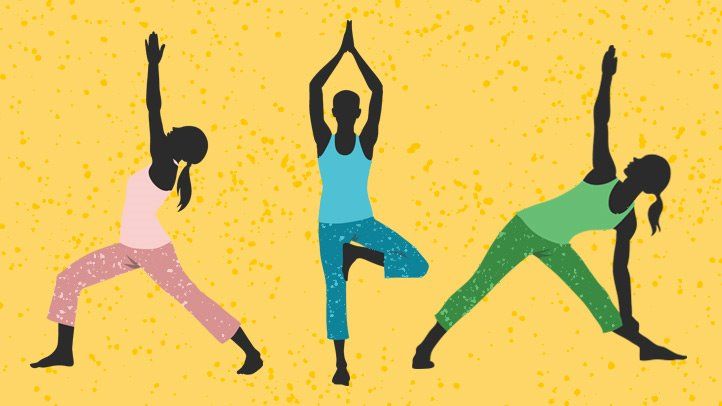
Chronic pain is a debilitating condition that affects millions of individuals worldwide. While yoga has long been praised for its physical and mental benefits, its potential effects on chronic pain remain largely unexplored.
In this article, we delve into the science behind yoga's impact on pain perception, endorphin release, stress hormones, inflammation reduction, nervous system regulation, muscle tension relief, improved circulation, and emotional well-being. By shedding light on these unexplored aspects, we hope to offer a comprehensive understanding of how yoga can provide relief and improve the quality of life for those living with chronic pain.
Pain Perception
Pain perception is a complex physiological process that involves the transmission and interpretation of nociceptive signals by the central nervous system. Understanding how pain is perceived in the body is essential for exploring the potential effects of yoga techniques on chronic pain.
Research has shown that there is a strong mind-body connection when it comes to pain perception. The brain plays a crucial role in modulating pain signals, and factors such as emotions, beliefs, and past experiences can influence the experience of pain.
Yoga techniques, such as deep breathing, meditation, and physical postures, have been found to have positive effects on pain perception. These techniques can help individuals relax, reduce stress, and increase their pain tolerance.
Endorphin Release
Endorphin release is a crucial aspect of yoga's effect on chronic pain management.
Endorphins are natural pain-relieving substances produced by the body, acting as neurotransmitters that bind to opioid receptors in the brain.

Through the practice of yoga, the physical postures, breathing techniques, and meditation can stimulate the release of endorphins, leading to a reduction in pain perception and an overall sense of well-being.
Understanding the role of endorphins in pain relief can provide insights into the mechanisms behind the effectiveness of yoga as a complementary therapy for chronic pain.
Pain Relief Mechanism
One of the unexplored aspects of yoga's effect on chronic pain lies in the understanding of the mechanism by which it promotes pain relief through the release of endorphins. Endorphins are naturally occurring chemicals in the body that act as pain relievers and mood enhancers.
When released, endorphins bind to opioid receptors in the brain, spinal cord, and other parts of the body, reducing the perception of pain. The pain modulation system in the body involves a complex network of neural pathways that transmit and regulate pain signals.
Yoga practices, such as deep breathing, meditation, and specific postures, have been shown to activate these neural pathways, leading to the release of endorphins and subsequent pain relief. However, further research is needed to fully understand the specific mechanisms by which yoga promotes endorphin release and pain modulation, providing valuable insights into the potential benefits of yoga for chronic pain management.
Neurotransmitter Role
The role of neurotransmitters in the release of endorphins during yoga practice is a crucial aspect that remains unexplored in understanding the effect of yoga on chronic pain. Neurotransmitter modulation plays a significant role in pain perception and management.
Endorphins, which are endogenous opioids, are known to be released during exercise, including yoga. These neurotransmitters bind to opioid receptors in the brain and spinal cord, leading to pain relief and an enhanced sense of well-being. However, the specific mechanisms by which yoga stimulates endorphin release and the extent of their contribution to pain relief are still not fully understood.

Furthermore, the neuroplasticity effects of yoga on neurotransmitter systems need to be explored to determine its long-term impact on chronic pain management.
Further research in this area could provide valuable insights into optimizing yoga as a complementary therapy for chronic pain.
Stress Hormones
Stress hormones play a crucial role in our body's response to stress and can have a significant impact on chronic pain.
Yoga has been shown to regulate cortisol levels, which is the primary stress hormone, helping to restore hormonal balance.
By reducing stress and promoting relaxation, yoga can potentially alleviate chronic pain by influencing the body's stress hormone response.
Further research is needed to fully understand the mechanisms by which yoga affects stress hormones and its implications for chronic pain management.
Cortisol Regulation in Yoga
Examining the influence of yoga on cortisol regulation provides valuable insight into the management of stress hormones in individuals with chronic pain.

Cortisol, commonly known as the stress hormone, is released by the adrenal glands in response to stress. Chronic pain can lead to increased stress levels, resulting in elevated cortisol levels.
Yoga, with its focus on the mind-body connection, has been found to have a positive impact on cortisol regulation. Several studies have demonstrated that practicing yoga can reduce cortisol levels, leading to a decrease in stress and improved immune response.
The deep breathing, relaxation techniques, and physical postures involved in yoga help activate the parasympathetic nervous system, promoting a state of relaxation and reducing cortisol production.
This suggests that incorporating yoga into the management of chronic pain may help regulate stress hormones and improve overall well-being.
Hormonal Balance and Stress
Recent research has shed light on the intricate relationship between hormonal balance and stress, unveiling the profound impact of stress hormones on overall well-being.
Hormonal imbalance, often triggered by chronic stress, can have detrimental effects on various bodily functions and contribute to the development of numerous health conditions.
Stress hormones, such as cortisol and adrenaline, play a crucial role in the body's response to stress, but when they are consistently elevated due to chronic stress, they can disrupt the delicate balance of hormones in the body. This can lead to a range of physical and mental health issues, including fatigue, weight gain, mood swings, and impaired immune function.

Managing stress effectively is crucial for maintaining hormonal balance and overall well-being.
Yoga, with its focus on breath control, mindfulness, and physical movement, has been shown to be an effective tool for stress management, helping to restore hormonal balance and alleviate the symptoms of hormonal imbalance.
Impact on Chronic Pain
Yoga's effect on chronic pain can be understood through examining its impact on stress hormones. Chronic pain is often associated with increased levels of stress hormones such as cortisol, which can exacerbate pain and inflammation in the body. However, research suggests that practicing yoga techniques, including mindfulness meditation, can have a positive influence on stress hormone levels and subsequently alleviate chronic pain.
Yoga techniques, such as deep breathing and gentle stretching, activate the body's relaxation response, reducing the production of stress hormones.
Mindfulness meditation, a key component of yoga, helps individuals become more aware of their pain and develop non-judgmental acceptance, leading to a reduction in stress hormone release.
Regular yoga practice has been shown to improve overall stress management, leading to a decrease in chronic pain symptoms.
Inflammation Reduction
The study explores the potential of yoga to reduce inflammation in individuals suffering from chronic pain.

Chronic pain is often associated with increased inflammation in the body, which can lead to further discomfort and health complications.
Yoga, with its emphasis on the mind-body connection, has been shown to have positive effects on the immune response, which plays a crucial role in regulating inflammation.
Several studies have demonstrated that practicing yoga can lead to a reduction in pro-inflammatory markers, such as cytokines, while increasing anti-inflammatory markers, such as interleukin-10.
This suggests that yoga may have a direct impact on the immune system, helping to modulate the inflammatory response in individuals with chronic pain.
Further research is needed to fully understand the mechanisms behind this inflammation reduction and to explore the potential of yoga as a complementary therapy for managing chronic pain.
Nervous System Regulation
Research has revealed the potential of yoga to regulate the nervous system in individuals with chronic pain. Yoga practices such as asanas, pranayama, and meditation have been found to positively impact the nervous system, leading to improved pain management and overall well-being.
Here are three ways in which yoga regulates the nervous system:

- Neuroplasticity: Yoga has been shown to enhance neuroplasticity, which is the brain's ability to reorganize and form new neural connections. This can lead to a reduction in pain perception and an improved ability to cope with chronic pain.
- Immune response: Chronic pain is often associated with inflammation and immune dysfunction. Yoga has been found to modulate the immune response, reducing inflammation in the body and promoting healing.
- Stress reduction: Chronic pain is closely linked to stress, which can exacerbate pain symptoms. Yoga practices help regulate the stress response, leading to a decrease in stress hormones and a greater sense of calm and relaxation.
Muscle Tension Relief
One important aspect of yoga's effect on chronic pain is its ability to provide relief from muscle tension. Chronic pain often leads to increased muscle tension, which can further exacerbate the pain cycle. Yoga helps to address this by promoting a mind-body connection and activating the relaxation response in the body.
The mind-body connection in yoga involves focusing on the breath and bringing awareness to the body's sensations. This mindfulness allows individuals to identify areas of tension and consciously release it through specific yoga poses and stretches. By incorporating deep breathing techniques, yoga also activates the relaxation response, which is the body's natural mechanism for reducing stress and tension.
Research has shown that regular yoga practice can significantly reduce muscle tension and improve flexibility. A study published in the Journal of Pain Research found that individuals with chronic low back pain who practiced yoga experienced a reduction in muscle tension and reported improved function and decreased pain intensity.
Improved Circulation
Yoga's impact on chronic pain extends to improved circulation, a crucial element for pain management and overall well-being. The practice of yoga promotes better circulation by enhancing oxygen delivery to the body's tissues and improving vascular health. Here are some ways in which yoga contributes to improved circulation:
- Deep breathing techniques: Yoga involves deep, controlled breathing exercises that increase the oxygen supply to the bloodstream. This helps nourish the cells and tissues, improving their overall function.
- Physical movement: The various yoga poses and sequences involve gentle stretching and movement, which stimulate blood flow throughout the body. This increased blood circulation helps remove waste products and toxins from the tissues, promoting healing and reducing pain.
- Relaxation and stress reduction: Yoga incorporates relaxation techniques such as meditation and mindfulness, which help reduce stress and tension. Lower stress levels have been shown to improve vascular health and enhance blood flow.
Emotional Well-being
The impact of yoga on chronic pain extends to emotional well-being, as evidenced by its positive effects on mental health and psychological resilience. Numerous studies have shown that practicing yoga regularly can lead to mood enhancement and improved psychological well-being.
Yoga has been found to reduce symptoms of depression and anxiety, two common emotional issues associated with chronic pain. It promotes the release of endorphins, which are natural mood enhancers, and increases levels of gamma-aminobutyric acid (GABA), a neurotransmitter that helps regulate mood and reduce anxiety.
Furthermore, yoga improves psychological resilience by enhancing coping mechanisms and stress management skills. It encourages mindfulness and self-awareness, allowing individuals to better understand and regulate their emotions. This can result in improved emotional stability and a greater sense of well-being.

Frequently Asked Questions
Can Practicing Yoga Completely Eliminate Chronic Pain?
Practicing yoga has shown promise in reducing chronic pain, but complete elimination may not be guaranteed. Studies indicate that yoga's impact on mental health and the role of mindfulness in pain management contribute to its potential effectiveness.
Are There Any Specific Yoga Poses or Techniques That Are More Effective in Reducing Inflammation?
Specific yoga poses or techniques for reducing inflammation have not been extensively studied. However, breath control, known as pranayama, plays a crucial role in pain management and may help alleviate inflammation when practiced in conjunction with yoga.
How Long Does It Typically Take for Yoga to Start Showing Noticeable Improvements in Chronic Pain?
It typically takes a few weeks to a few months of regular yoga practice to start showing noticeable improvements in chronic pain. Yoga's role in improving mental health and its impact on overall quality of life are also significant.
Can Yoga Help With Managing Chronic Pain Caused by Conditions Such as Fibromyalgia or Arthritis?
Yoga has shown promise in managing chronic pain caused by conditions like fibromyalgia and arthritis. Research suggests that yoga's impact on cognitive function and its incorporation of mindfulness techniques may contribute to its effectiveness in pain management.
Potential risks and safety concerns associated with using yoga as a form of pain management for chronic conditions are not yet fully explored. Further research is needed to determine any possible side effects and ensure the safety of individuals with chronic pain.
 Business & FinanceHealth & MedicineTechnologyLifestyle & CultureScience & EnvironmentWorld NewsPrivacy PolicyTerms And Conditions
Business & FinanceHealth & MedicineTechnologyLifestyle & CultureScience & EnvironmentWorld NewsPrivacy PolicyTerms And Conditions
